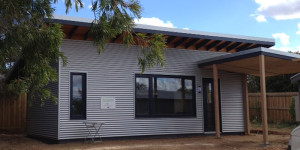Passiv Haus
What is a Passiv Haus (Passive House)?
Well as you might have guessed the term originates in Germany, and relates to a method of achieving more sustainable performance (and lower Energy Bills)
It’s a technique which doesn’t rely on good orientation, high thermal mass and natural cross flow ventilation to provide comfortable conditions with low energy use.
The house on the right, built in Castlemaine by Carbon-Lite, is said to be the first Passiv Haus built in Australia
Some of the key Passiv Haus characteristics are:
High Levels of Thermal Insulation
All the exterior envelope (walls and roof) of the house are very well-insulated with a maximum Heat Transfer Coefficient, U-value of 0.15 W/m²K (R=6.6)
This is much better than:
- A typical Brick Veneer Wall – U value 0.51 (R = 1.92)
- A typical Roof – U value 0.26 (R = 3.91)
Elimination of Thermal Bridges
All Wall openings, corners, connections and penetrations are designed, and constructed, with great care, so that thermal bridges can be minimised.
Highly Insulated Windows:
Typically triple glazed windows will be required to achieve appropriate insulation
Air Tightness of the Building:
Uncontrolled air changes from gaps must be smaller than 0.6 of the total house volume per hour which is much better than 1.0 of the total house volume per hour that would be more typical of a new house.
To achieve Passiv Haus certification involves a test where the house is pressurised using a temporary ‘Blower Door’.
Energy Recovery Ventilation:
Because the house will be quite airtight a mechanical ventilation is required to keep the air fresh and prevent condensation.
Passiv Haus systems have highly efficient energy recovery ventilation systems
In Winter around 75% of the energy from the exhaust air is used to warm the fresh air again by means of a heat exchanger.
In summer the exhaust air is used to cool the incoming air
The ventilation systems also incorporate pollen and dust filters.
For more information go to the The Australian Passive House Association.